Where to Stay in Barcelona: Complete Guide for First Timers
Barcelona is a beautiful city that has been one of the most visited places in Europe for decades at this point. Beaches, perpetual sun (though on my last trip it did rain about two inches in 24 hours), and a great food scene – what, exactly, is not to love?
However, if you’re willing to dive a little deeper, Barcelona and the broader region of Catalonia have an interesting history and culture that is unique within Spain.
We first visited Barcelona together a few years ago(though we had each been before, separately), and we spent a week exploring the city and getting beneath the surface level.
We spent hours at the Museu d’Història de Catalunya, walked miles and miles all over the city, and discovered the beautiful drink that is Spanish vermouth (vermut).
Last year, I (Matt here) made a return trip to Barcelona for a nice springtime trip full of gluten free food, deeper dives into Barcelona’s history and culture, and modernist architecture.
I was there at the end of April and it was VERY BUSY, so it’s important to book your place to stay well in advance.
I made some wholesale changes to this guide based on that more recent experience, doing my best to streamline it and give you all the information you need to figure out where to stay.
In this guide, we’re going to use our experiences exploring the city to do our best to walk you through all the information you need to figure out where to stay in Barcelona for your particular style, budget, and preferences.
Each neighborhood offers a different blend of vibes, prices, and pros and cons, and we’ll cover it all below so that you’re armed with all the information you need to figure out where to stay for your particular style and budget.
Our intention is that, by the end of this guide, you have everything you need to choose the right place to stay for you and your travel companions.
Sound good to you? Let’s get into it.
Important note: This is a long guide with lots of detail (it got longer and longer as we put it together), but we’ve done our best to structure it with headings, a helpful summary at the top, and a table of contents to help you navigate it without reading literally every word.

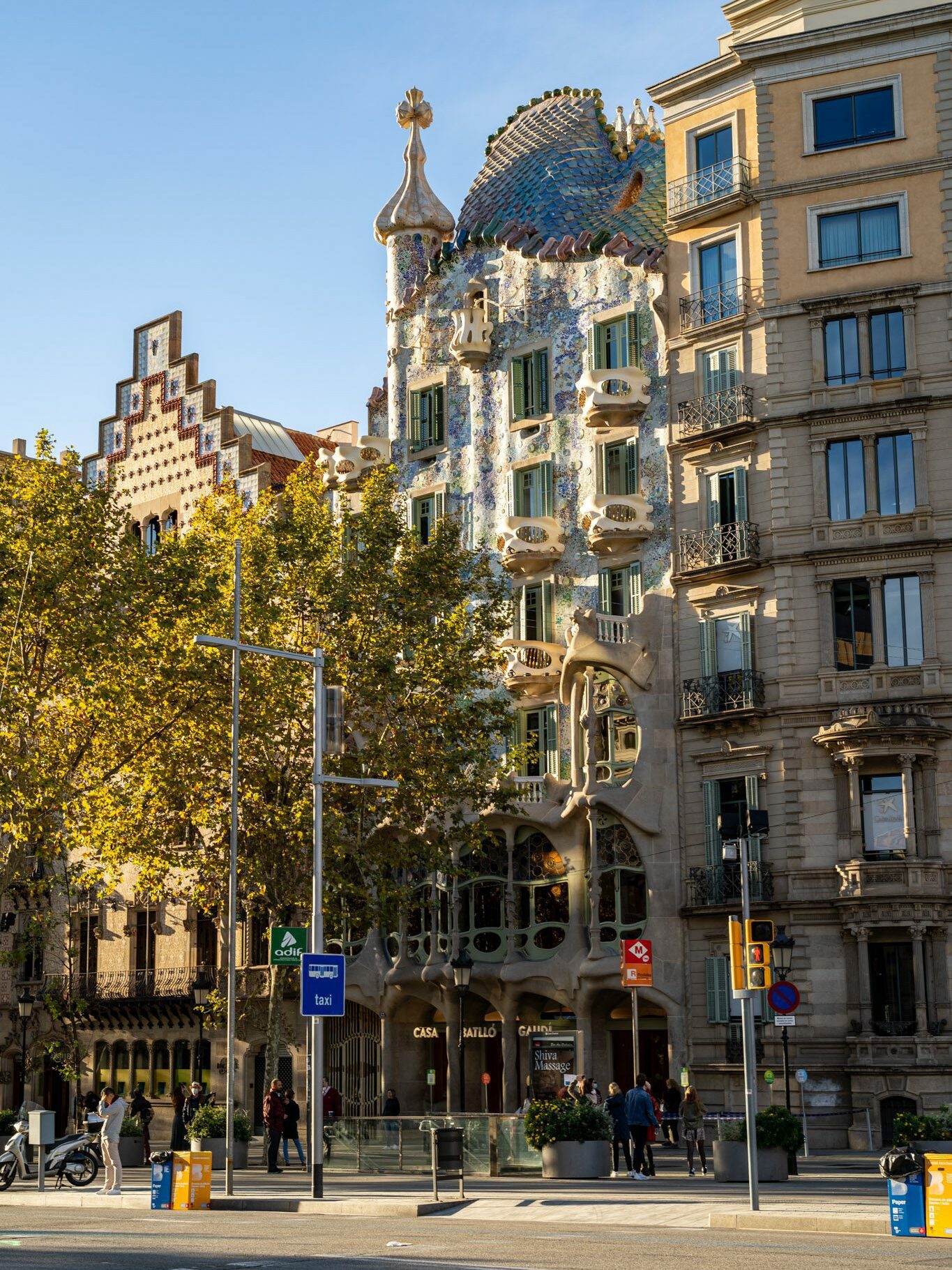
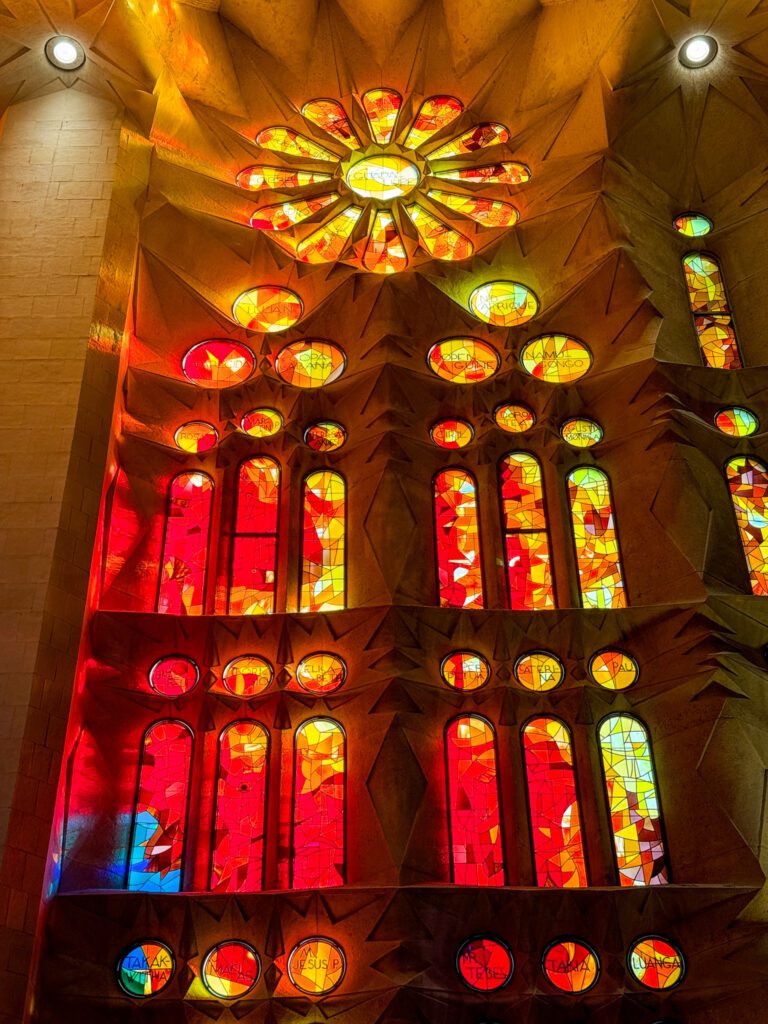
Disclaimer: Some of the links in this post, like hotel links, are affiliate links, meaning at no additional cost to you, we make a little bit of money if you click through and book. That being said, we would never recommend something to you that we don’t stand behind 100%.
Where to Stay in Barcelona: 5 Great Neighborhoods
We’re going to get straight into it here, because there’s a lot to cover!
Our philosophy when it comes to deciding on a place to stay is to first choose the neighborhood, then move on to finding a great hotel, hostel, or apartment in that area.
The reality is that, depending on what you’re looking for, there are other neighborhoods not included in this guide that might meet your needs.
But these are the five that we think are the best for 99% of travelers, and we’ve shown our work, doing our best to explain why we think that.
Now, we’re well aware that a few of you are currently ready to throw your left shoe at the screen, saying “I don’t have time to read all of that, JUST TELL ME THE BEST PLACE TO STAY!”
Well, here’s a quick summary of this guide if you’re short on time (though we’d recommend reading the section of the place you end up staying for tips and places to add to your list!).
If it’s your first time in Barcelona, you can’t go wrong with staying centrally in l’Eixample.
It’s right in the center of the city, connecting the historic center with the outer ring of more residential neighborhoods.
It’s conveniently located between the Old City and Gràcia, and it’s well connected to just about every place you’ll want to visit over the course of your Barcelona itinerary.
This part of the city is full of great hotels – we’ve stayed at and would recommend Casa Bonay (a beautiful boutique hotel) and Praktik Essens (a nice mid-range option).
While this is probably the most upscale neighborhood in central Barcelona, there are a couple of relatively affordable options like Limonaia and Mosaic by Ona.
Our top recommendation is to find a charming hotel or guesthouse in Gràcia, which is far and away our favorite part of Barcelona.
Cobblestone streets, energetic plazas, and some of the best bars and restaurants in the city? Sign us up.
If you want a nice, affordable guesthouse in a nice location, stay at Casa Mathilda.
If you want to stay in an apartment for a little more space, look at Be Mate Paseo de Gràcia.
If you’re really on a budget, either look at Casa Jam (a boutique hostel with private rooms and nice facilities – we were going to stay here a few years ago but chose elsewhere) or Hotel Ronda Lesseps (it’s a little further north, so you’re trading location for affordability).
If you want to stay in the Cituat Vella, we’d choose El Born, a hip part of Barcelona that’s near the Gothic Quarter and waterfront, and is packed full of bars, restaurants, cafes, and more.
It’s a good central location, and generally feels much more authentic than, say, the Gothic Quarter.
For an affordable guesthouse, look at Casa Consell. For a more upscale hotel, look at the Mercer Hotel.
If you’re traveling with a group of family or friends, skip vacation rentals (which are borderline illegal in Barcelona) and look at aparthotels, which combine the convenience of a hotel (luggage storage, flexible check-in) with the amenities of an apartment (kitchens, more space, etc).
Our top choice would be Apartments Sixtyfour, which is right on Passeig de Gracia (within a few blocks of two Gaudí buildings) and has a bunch of two bedroom apartments with full kitchens and lots of space.
We like the look of the apartments at Vale Suites in l’Eixample, which are well connected and walkable (without being right in the middle of the action). They have one and two bedroom apartments that would work for groups.
Last but not least, look at Numa Colmena, an aparthotel brand we’ve stayed at in other cities in Spain. It’s a little further out in a more residential corner of Gràcia, but they have multiple bigger configurations (including three bedrooms!).
While you’re in Barcelona, you’re probably going to want to see some of the main Gaudí sights, like the Sagrada Familia and Casa Batlló.
Don’t miss our favorite tour company in Europe, Walks, who has an excellent extended Gaudí tour that covers most of those main sights, and a tour of the Sagrada Familia at closing time.
I (Matt here!) did the Gaudí tour (linked above) on my trip this year because I was looking for a deeper understanding of his influence on the city, and the tour did not disappoint (despite the fact that I had done the main sights before, sometimes multiple times).
I truly love the Sagrada Familia despite the fact that I’m not a huge “see all the churches” person. That basilica is on a different level – the level of care and craft that has gone into every single detail is truly mind blowing.
If you only have time for one tour in Barcelona, I’d choose a tour of the Sagrada Familia so that you have the context and understanding of the details to truly appreciate it.
We’ve now done at least seven tours with Walks over our travels the past few years, and have always been impressed with both their itineraries and their guides. You can read about our experience on their Colosseum Tour in Rome here.
Where We’ve Stayed in Barcelona
Our own personal experience might be a good place to start this guide.
At this point, we’ve stayed in several different places, so it makes the most sense to give you a list of the places we stayed with some brief thoughts on why we think they’re worth your time (or who should consider staying there).
We should note that there are two places we’ve stayed that we are just not going to include below because, frankly, we think there are better options.
At a high level, we’ve basically split our time between Gràcia and l’Eixample, which are BY FAR our two top recommendations for your stay in Barcelona (and they’re essentially tied after I, Matt, spent more time staying in l’Eixample on my latest foray into Barcelona).
You’ll find more detail in the longer guide below on why we think that and the specific hotels in this section.
Praktik Essens (l’Eixample): This hotel sits at the southern end of Passeig de Gràcia – one of the main stretches running through the middle of Barcelona – which is full of great bus and metro connections and is about as walkable as it gets.
In a city like Barcelona, where hotels are extremely expensive, I’d put this in the mid-range category.
My room was lovely and spacious, and the shared facilities (including a lounge area and shared terrace) are nice.
Casa Bonay (l’Eixample): This is my favorite place I’ve stayed in Barcelona (really, all of Spain).
It’s a beautiful hotel with nice facilities, a rooftop bar (and a rooftop terrace for guests only), and comfortable rooms with nice design elements. It’s on a sunny corner in l’Eixample, and though it’s not cheap, I’d say it was worth the splurge.
We didn’t love the specific place we stayed in Gràcia (it just needed a bit more TLC and updating), but there are plenty of good options in the neighborhood.
We’d probably choose Be Mate Paseo de Gràcia, an aparthotel right on the main stretch (with great metro and bus connections) with modern rooms, including spacious apartments with kitchens.
Gràcia: Our Favorite Neighborhood in Barcelona
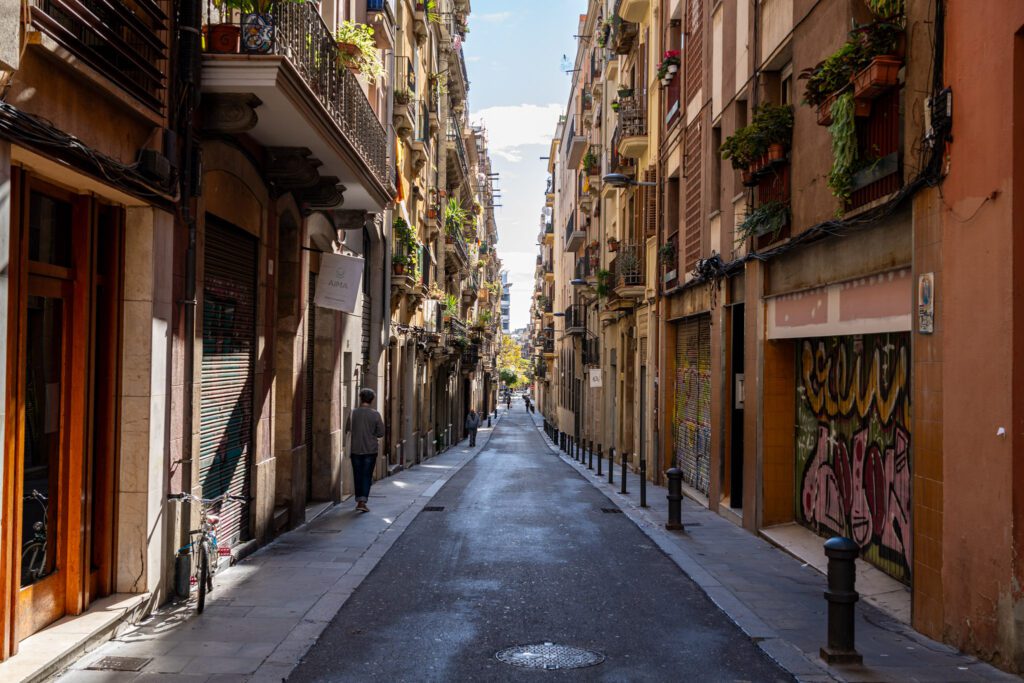
We stayed in Gràcia for the majority of our foray into Barcelona a couple of years ago, and loved it.
It will 100% be the place we stay the next time we find ourselves in the Catalonian capital, which is about as good an endorsement as we can give.
At one point, Gràcia used to be a completely separate village from Barcelona, and it’s easy to imagine that being the case as you stroll the streets early in the morning, before the hustle and bustle of Barcelona really gets going.
I’ve seen the word “bohemian” used a lot to describe Gràcia, and I’m still not quite sure exactly what the word means.
I think Gràcia is a little hipster, a little family-oriented with plenty of plazas and green spaces full of locals (and their kids and/or dogs) going about their days, and a lot charming and packed full of amazing food, drinks, and shops.
Gràcia is hip without falling into hipster cliches, managing to be both quiet and pedestrian friendly, yet also atmospheric and lively.
In short, we loved Gràcia, and think it would be a great home base for exploring Barcelona, especially if you want to stay somewhere that isn’t exclusively for tourists (though there are plenty of those around pretty much everywhere in Barcelona).
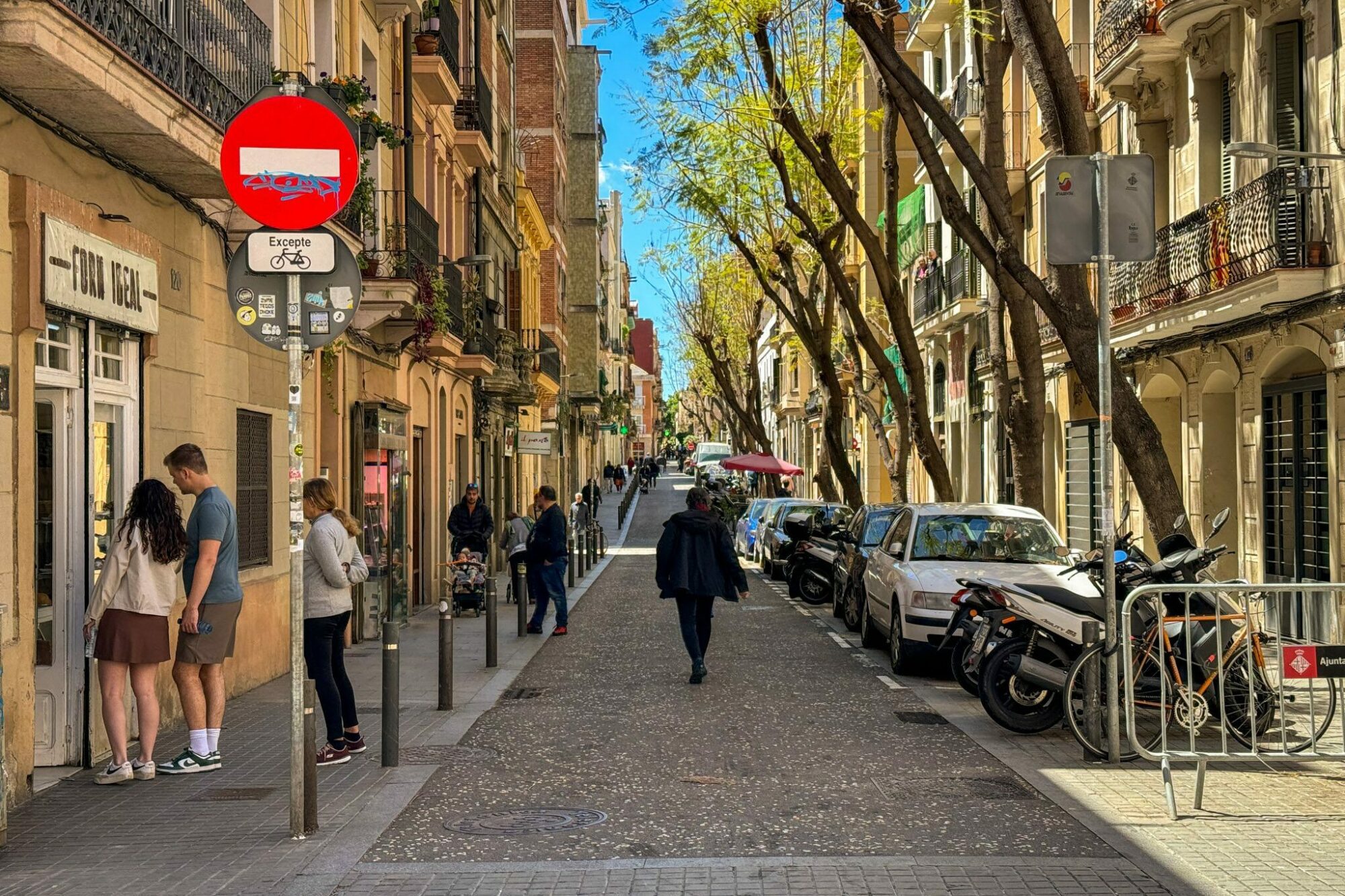
Pros and Cons of Staying in Gràcia
Here are the pros and cons of staying in Gràcia as we see them.
Pros of Staying in Gràcia
Great Transit Connections. There are two metro stops – Diagonal and Gràcia – that connect you to the L3 and L5 metro lines, which take you both downtown and to some of Barcelona’s main sights.
Community Feeling. Obviously, as a tourist, you’re not really going to ever be a part of a community when you’re traveling. But it is very pleasant to sit on a plaza and watch as people go about their daily lives and feel like you’re immersed in local life, even if it’s just for a few minutes.
The key is being respectful of that community – here’s how you can be a respectful tourist in Barcelona.
Great Food and Drinks. Whether you’re looking for a morning cup of coffee or a nightcap, Gràcia has a pretty incredible array of places to eat and drink at all hours.
It’s particularly energetic on warm summer evenings, when the outdoor terraces of nearly every bar and restaurant in the neighborhood are packed from 9:00 pm on.
Cons of Staying in Gràcia
Not Walkable to Ciutat Vella. While it’s walkable in terms of walking within the neighborhood, it does require a metro trip (or 30+ minute walk) to get to the Gothic Quarter and El Born.
Not Many Places to Stay. There aren’t that many choices in terms of places to stay. There are a few hotels and aparthotels, but the vast majority of the area is residential (and we think that you shouldn’t stay in an Airbnb in cities).
The Best Places to Stay in Gràcia
Here are some of our picks for the best places to stay in Gràcia.
Casa Mathilda: Independent Guesthouse with Great Walkability
Technically, Casa Mathilda is in l’Eixample, but it’s less than one block south of Avinguda Diagonal – which separates l’Eixample from Gràcia – so we’re going to put it in this section.
The location is great. It’s walkable to Gràcia, the Sagrada Familia, and the Ciutat Vella (it’s about 15-20 minutes on foot) – and it’s two blocks from Diagonal, a metro station with all sorts of connections to the rest of the city (not to mention the buses running down Ave Diagonal).
This is a pretty straightforward hotel that has a focus on sustainability and eco-friendliness.
It’s also independent, it’s not owned by one of the big hotel conglomerates (a rarity, especially in a city like Barcelona), and there are only 14 rooms, so it’s a pretty small operation. Which usually means better service.
There are only three room types to choose from here (no “premium”, “superior”, and “magnificent” tiers to choose from here). They have interior rooms, street facing rooms, and rooms with a private terrace.
Be Mate Paseo de Gràcia: Great Location with Hotel Rooms and apartments
Right on Passeig de Gràcia (which means you’re two to three minutes from a metro station that will connect you to the rest of the city), this hotel/apartment mix has rooms split between hotel-style rooms with king beds that are surprisingly spacious, and apartments (one or two bedrooms), which means that they probably have an option that’s right for you, whatever your style and budget.
Some of the hotel-style rooms have private terraces (yes please!), some have balconies.
The apartments are spacious and stylish, with full kitchens (with ovens and coffee makers) and plenty of room to spread out and relax.
If we were to do a trip to Barcelona again, this would be where we’d stay.
Feelathome Mozart Apartments: Spacious Apartments in a Great Location
A couple of blocks from Passeig de Gràcia (and the important Diagonal Metro Station, with two metro lines), this small apartment building has six apartments, all recently renovated and outfitted with air conditioning (a must-have for summer), full kitchens (with dishwashers), and washing machines.
If it’s available, grab the apartment with a terrace, where you can enjoy a sunset drink before heading out for a (late, because it’s Spain) dinner in the neighborhood.
They have options with one and two bedrooms, depending on your group size.
Casa Jam: An Affordable Guesthouse in a Quiet Location
If you know our story, then you know that we quit our jobs to bet it all on this website in early 2020 (WHOOPS), when we had planned to spend three months in Europe to kick off our new life.
For obvious reasons, that trip got delayed by about 18 months, but Barcelona was on both versions of the itinerary.
For that original trip, we had a room booked at Casa Jam in Gràcia (it was called Jam Hostel at that time).
This is an excellent option if you’re on a budget since it’s what we’d call a “boutique hostel,” which basically just means it has the room types of a hostel (a mix of dorm rooms and private rooms) with upgraded shared facilities that are more similar to a boutique hotel than a backpackers hostel.
They have private rooms with one double or two twin beds that are simple but comfortable and have ensuite bathrooms.
They also have some family rooms, which are essentially a private room with bunk beds in it that can be made up to have four or five beds in them.
The facilities include a shared kitchen, a spacious terrace, and a bunch of common areas where you can get some work done (or just enjoy the book you’re really into at the moment).
L’Eixample: A Close Second (Excellent Location!)
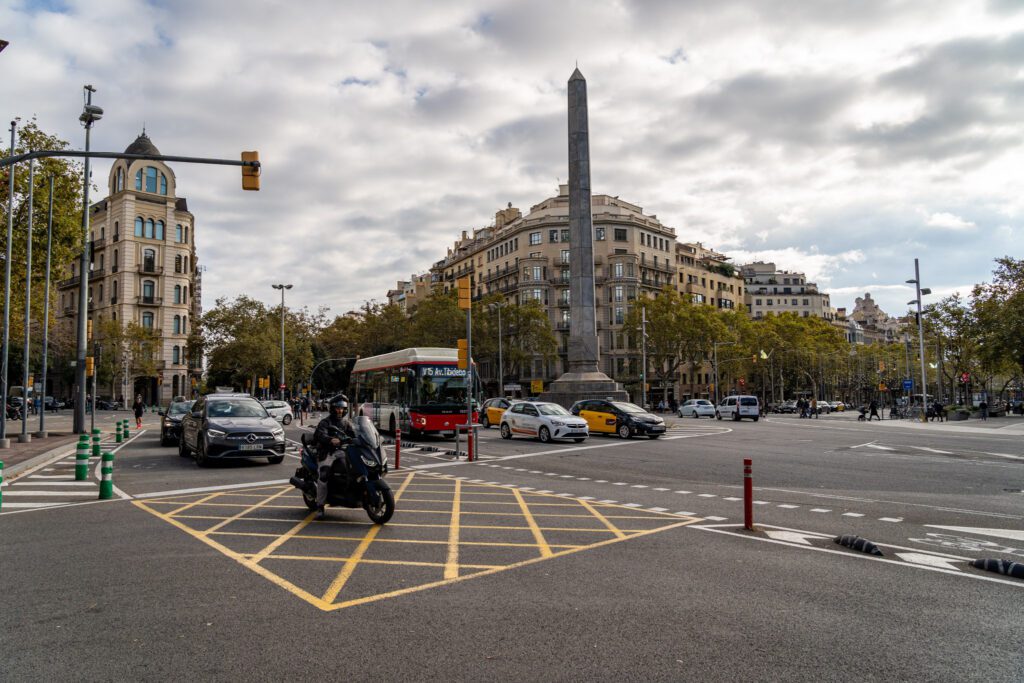
Compared to Gràcia, which feels very much like a small village within a big city with its narrow single lane streets, l’Eixample is the modern part of Barcelona.
L’Eixample was built as Barcelona expanded beyond the old city to connect the suburbs (at the time) like Gràcia to the core of the city.
The name literally means “the expansion” in Catalan because that’s exactly what it was.
It was designed to be modern, and is characterized by wide, multi-lane boulevards lined with tall buildings with commerce on the ground floor and housing on top floors.
Which is, well, very Parisian of them (don’t tell them I said that, though).
It’s on a tight grid, too, which can’t be said of the narrow alleyways of the Ciutat Vella (where I’ve definitely gotten lost before and had to pull out my phone to see exactly where I was).
It’s much, much more leafy than the Gothic Quarter, but not as much as Gràcia. It’s much more relaxed and laid back than the Gothic Quarter, but not as much as Gràcia.
It has more of a mix of tourists and locals, but not as much as Gràcia. See a pattern here?
In other words, it’s a compromise between the more laid back feeling you’ll find in Gràcia and the convenience you’ll get by staying more central.
Its superpower is being smack dab in the middle of the action. Which makes it an excellent base for exploring Barcelona.
It is worth noting that this particular neighborhood spans a wide area, basically all the way from Parc Ciutadella at its eastern end to the base of Montjuïc and Plaça d’Espanya to the west.
In general, we much prefer the area in the center of the neighborhood, just south of Gràcia and west towards Place de Catalunya.
This part of l’Eixample is full of tree-lined streets, places to eat and drink, and leans more towards Gràcia than the Gothic Quarter in terms of its feeling.
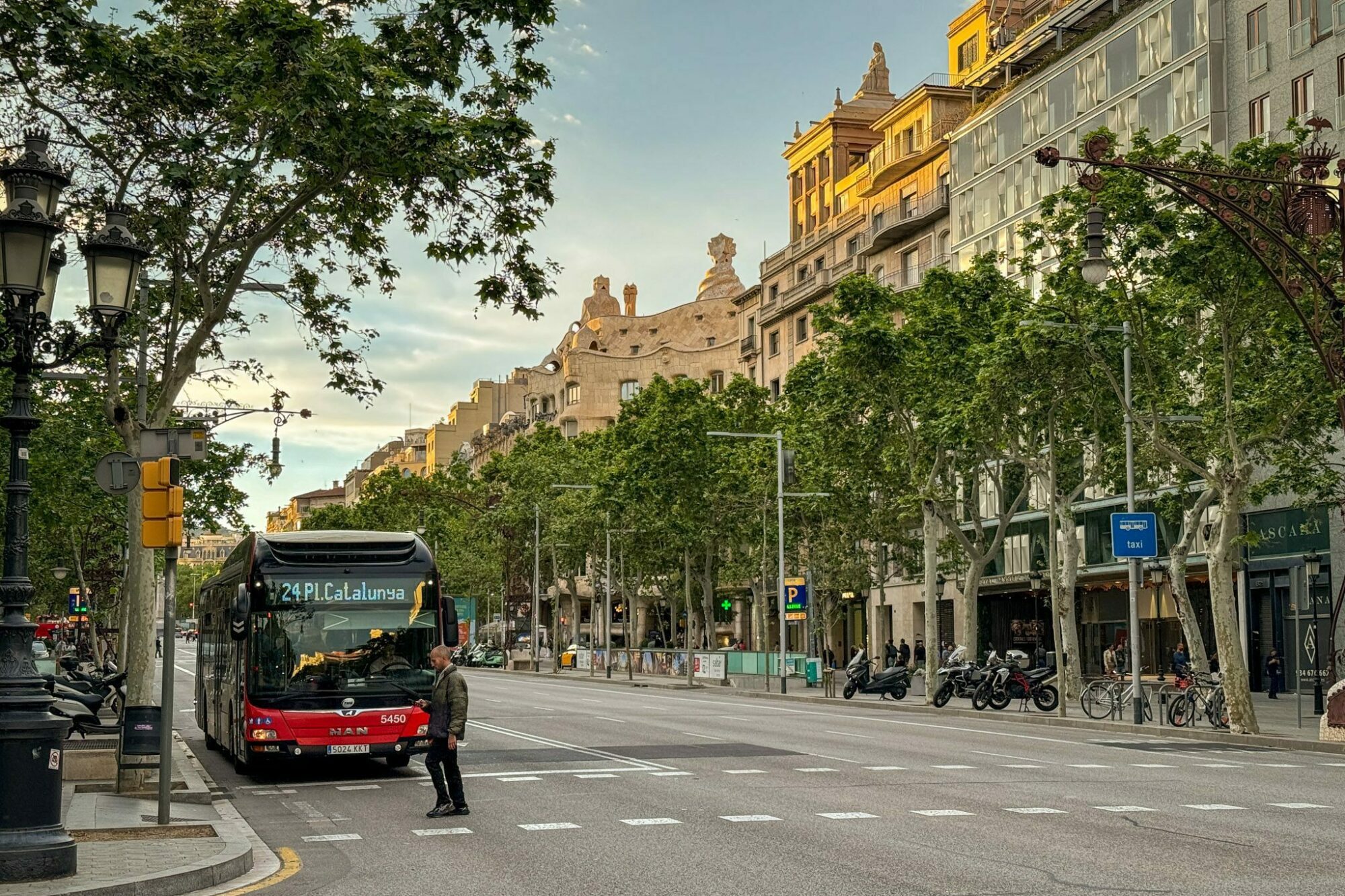
Pros and Cons of Staying in l’Eixample
Here are the pros and cons of staying in l’Eixample as we see them.
Pros of Staying in l’Eixample
Central and Well Connected. There’s probably no better place to stay in terms of walkability and transit connections. You could walk almost anywhere from your hotel, though most people will prefer to save time and energy by taking the metro, which has multiple lines running through the area.
Great Food and Drink Offerings. Coffee and food, in particular, are the winners here. Nightlife is a little lacking, but you can make the short journey to El Born for that.
Tons of Places to Stay. Whether you’re looking for a luxury hotel or a charming, affordable guesthouse, this neighborhood has a plethora of choices for you to choose from. All styles and budgets can find the perfect place to stay here.
Cons of Staying in l’Eixample
It Can Be Expensive. Who could have guessed that the area where you’ll find the Prada store in Barcelona would also be an expensive area to stay?
Lots of high-end hotels and shops here, which means you’ll likely be paying a little more than other places in Barcelona, though it’s arguably worth it for the central location.
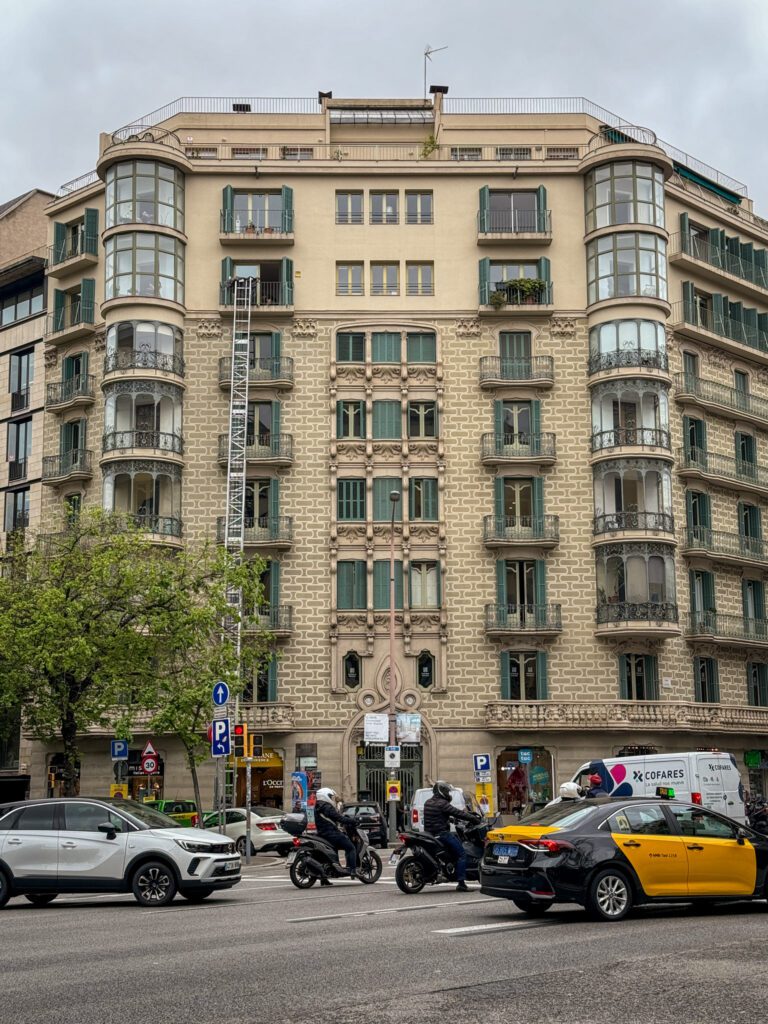
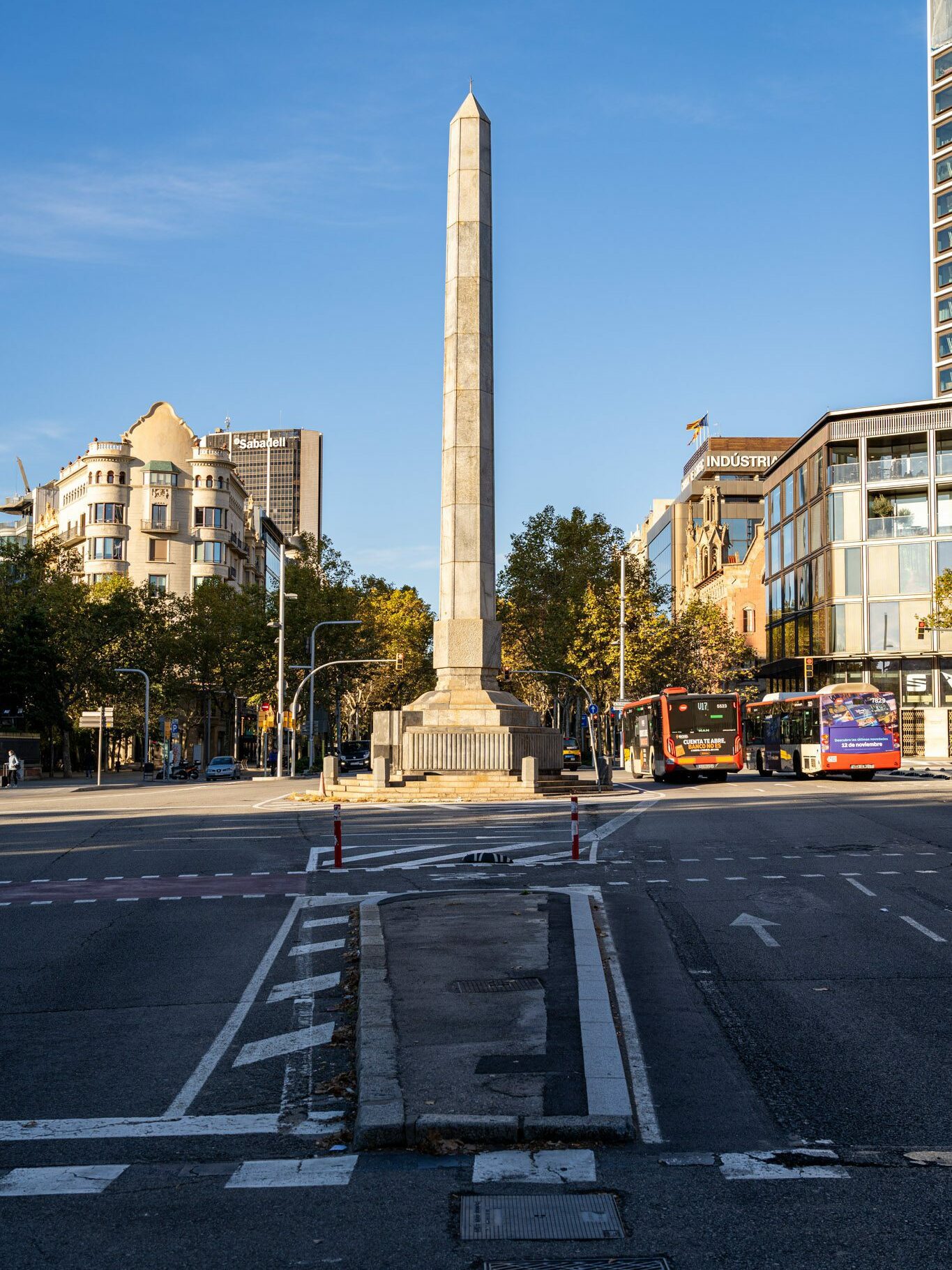
The Best Places to Stay in l’Eixample
There are a BUNCH of great places to stay in this part of Barcelona, here are a few that caught our eye.
Hotel Casa Bonay: Beautiful Boutique Hotel (Where We Stayed)
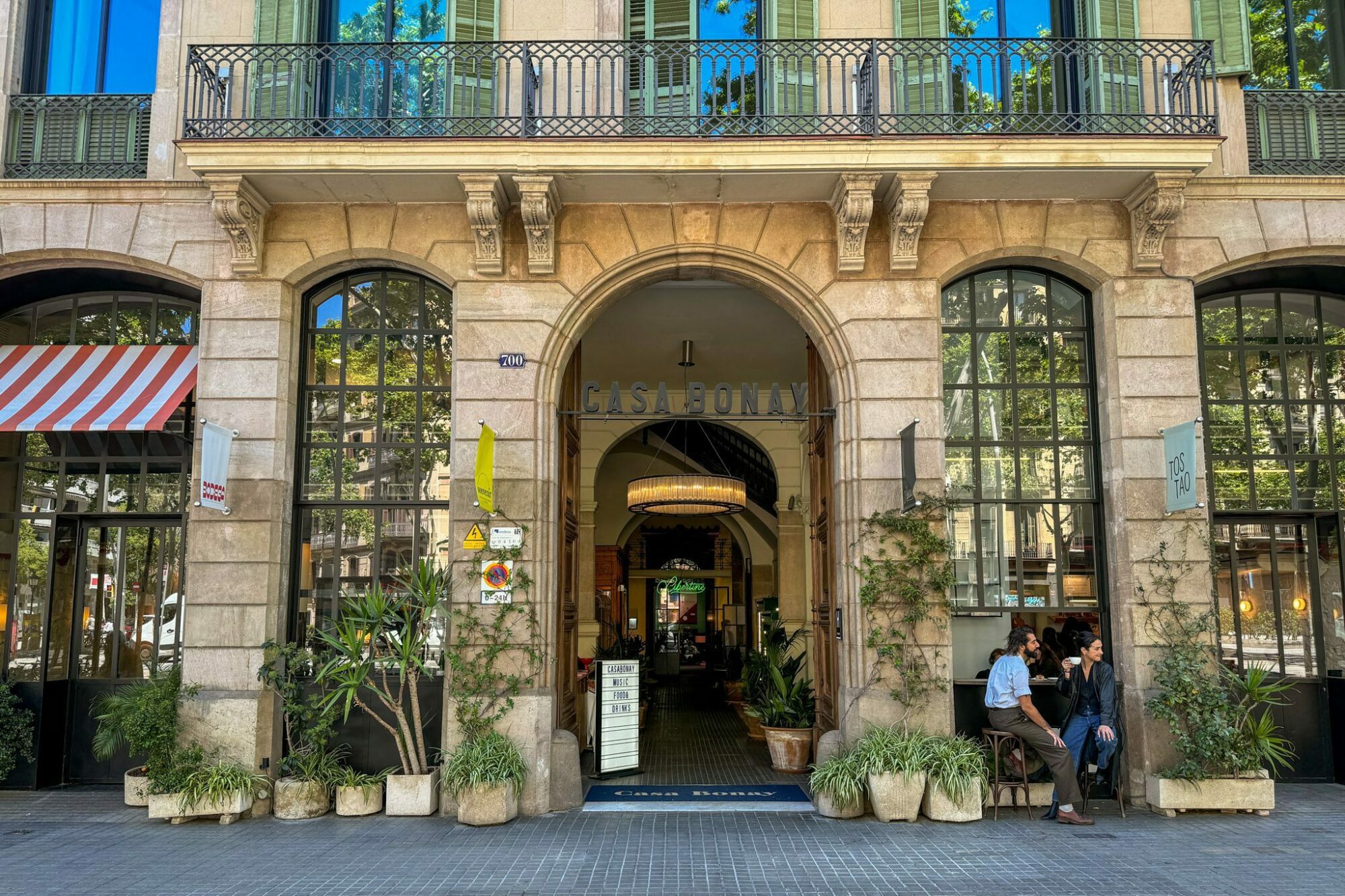
Based in a leafy area of l’Eixample, Casa Bonay is a stylish establishment with a mini-orchard on the rooftop and a beach hut inspired bistro.
It also has a great coffee shop in the lobby (you get a token for a complimentary cup of coffee during your stay when you check in).
The hotel is in a building from the 1800’s that has been completely redone by a local design firm, and now is one of the most stylish places to stay in the city.
Rooms are a bit below average in terms of size, but like many modern mid-range hotels popping up around the world, the idea is to sleep in your room, and use the hotel’s common areas as a place to relax, get work done, or get a quick meal in before heading out to explore.
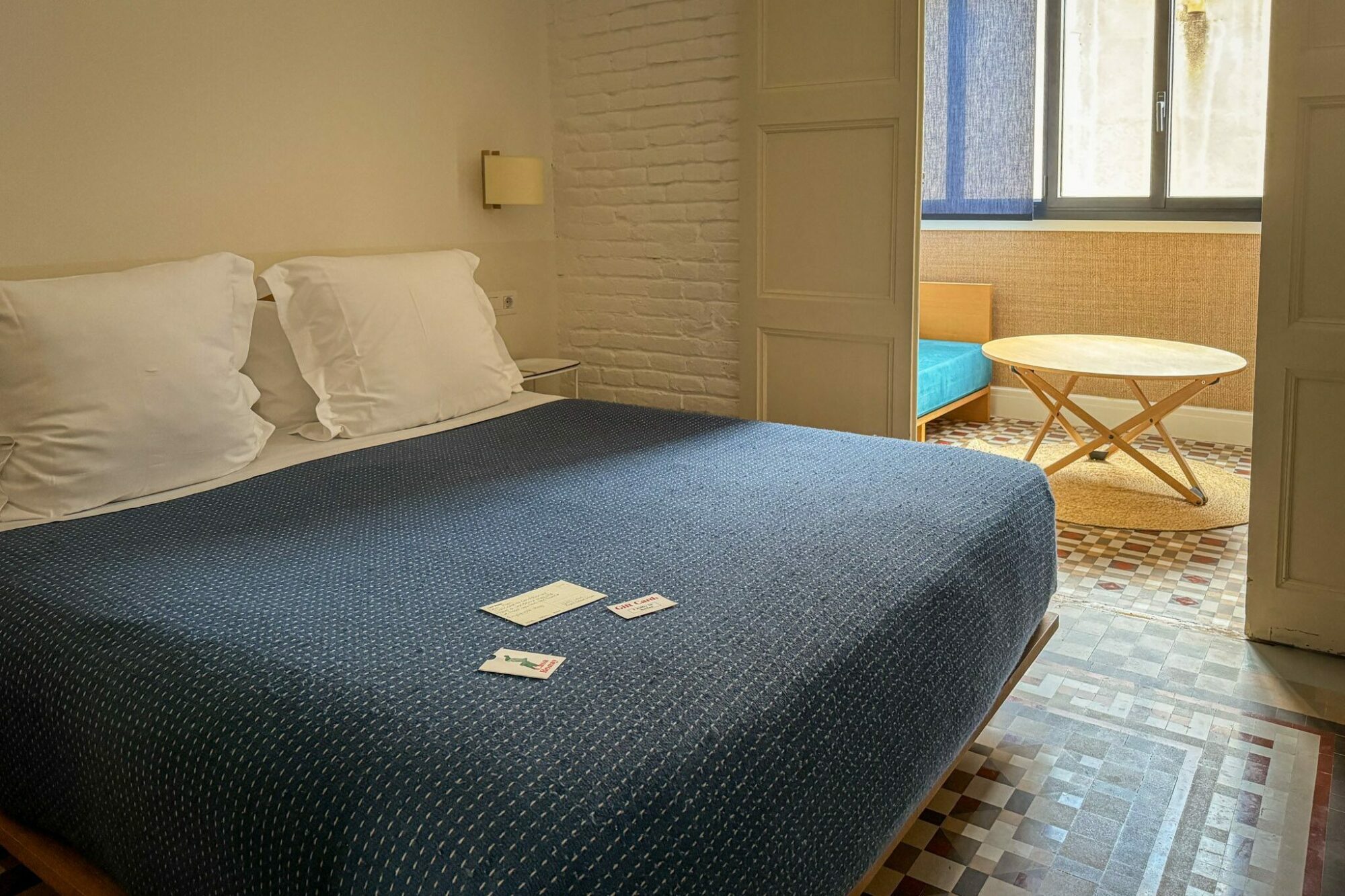
They do have larger rooms, with seating areas and plenty of space to spread out, but you’ll be paying a premium. I chose to do this so that I could have space to get some writing done, and found my room to be the perfect size.
My room had a lovely little sun room that had a view out over the city, and I spent my mornings there enjoying a cup of coffee and writing before heading out to explore.
They have a nice rooftop deck too, and it’s exclusive to people staying at the hotel (they also have a rooftop bar, which is not). There is also a cocktail bar and a coffee shop on the ground floor.
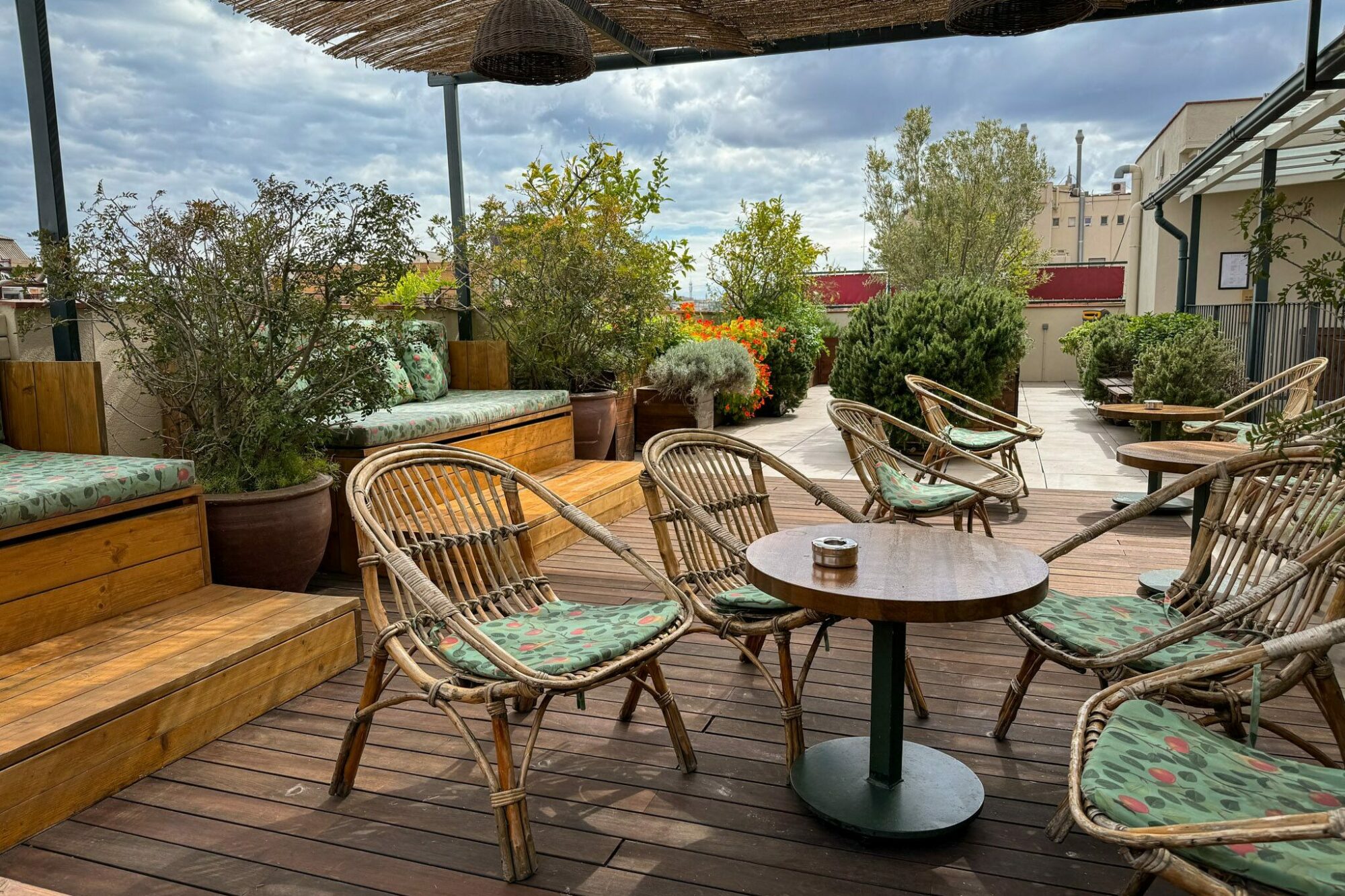
A couple of the rooms also have private terraces, some with outdoor showers.
The hotel is also something of a hotspot for local creative types, who you’ll find hard at work in the hotel’s gorgeous common areas on the ground floor.
Definitely recommended if you’re looking for a stylish place to spend your time in Barcelona.
Praktik Essens: A Mid-Range Hotel in a Great Location (Where We Stayed)
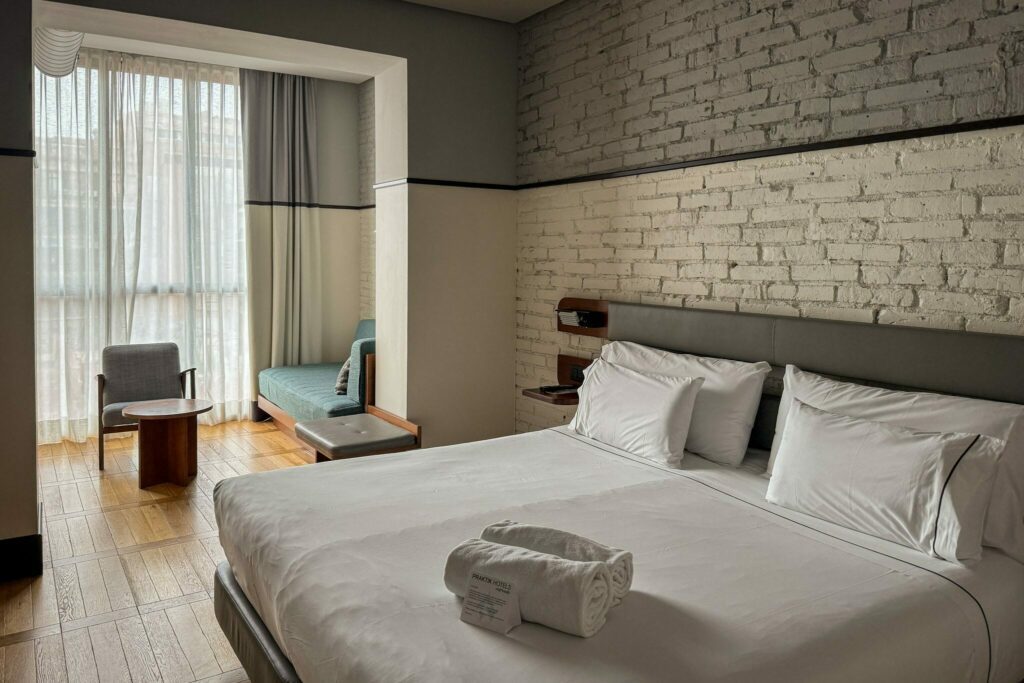
The next three hotels on this list are all from the same group – Praktik – and they’re all super fun, we think.
We really like the idea behind their hotels – each of their properties is designed around a central theme, and they give the modern traveler everything they need, nothing they don’t, all at a reasonable price.
Matt stayed at the “Essens” location, which is all about smell. From the perfumery in the lobby to the fragrant soaps in the rooms, everything is about your sense of smell.
As you walk through the sliding doors you’re greeted with a waft of floral smells that follow you throughout your stay.
The soaps in the rooms (both shower products and hand soap) all smell lovely, though I’m not sure if that’s different from any of their other properties.
I, Matt, chose this particular location because of… the location.
It’s right on Passeig de Gràcia – though at the southern end of the road, which puts it in l’Eixample. I walked almost everywhere, and everywhere I didn’t walk I was able to hop on the metro a few blocks away.
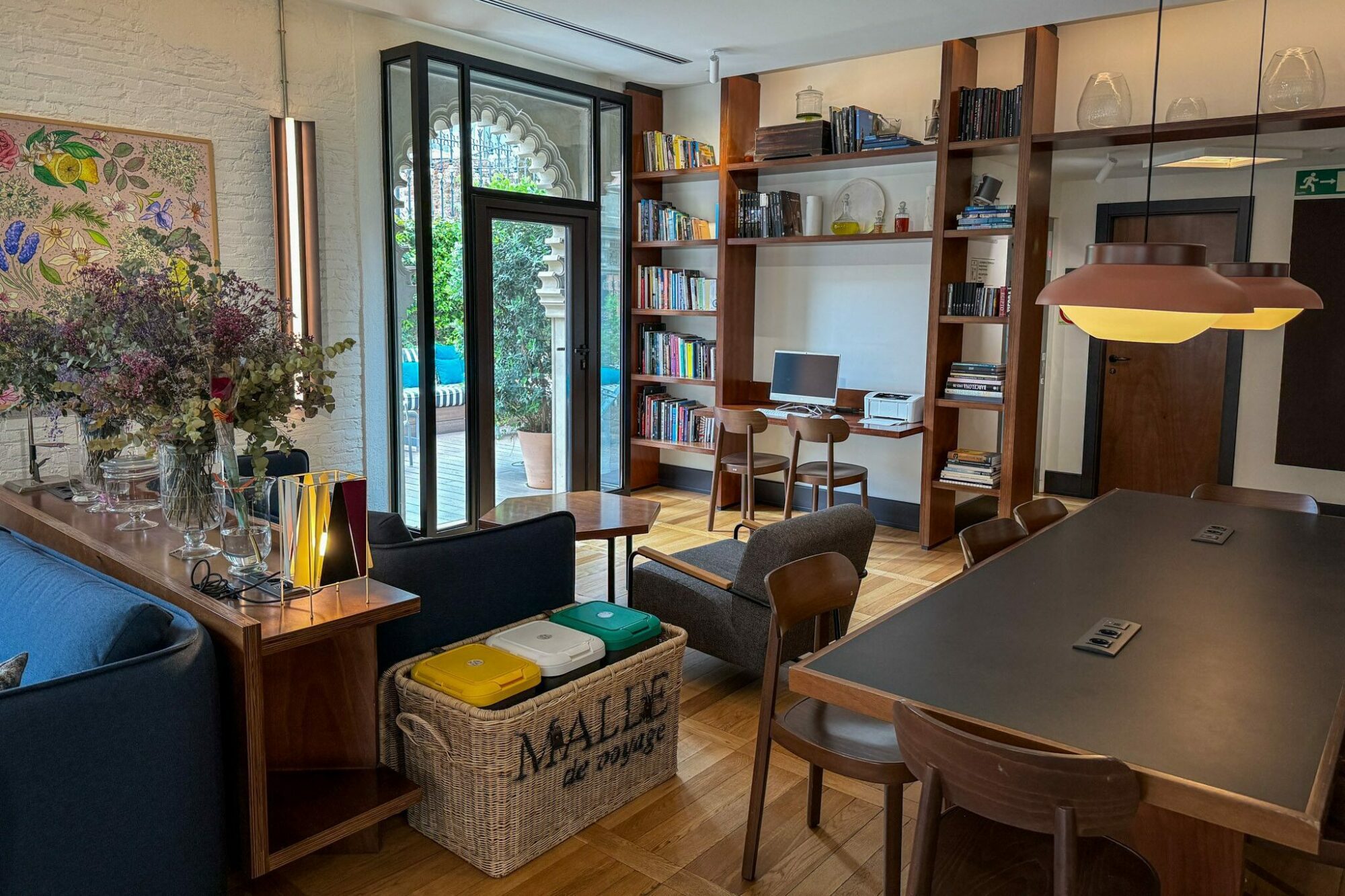
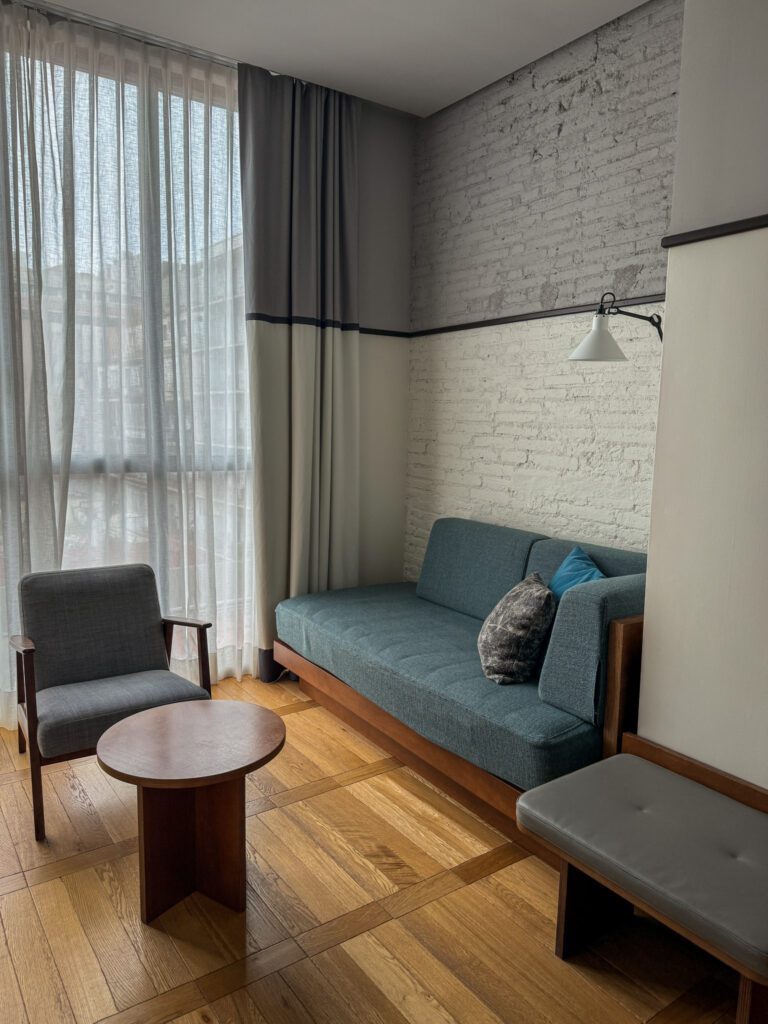
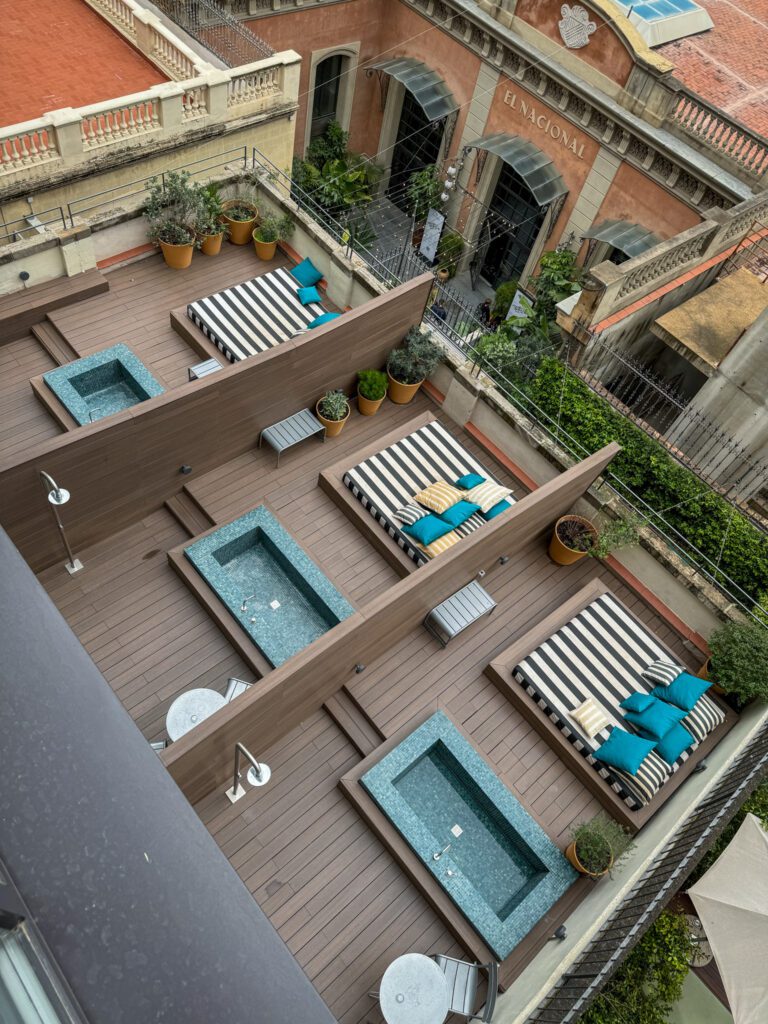
Rooms were refurbished recently, and they are cozy and compact, but that’s fine if you’re planning on spending most of your waking hours outside the hotel room.
Some rooms also have a private terrace with a hot tub, though you’ll have to pay a premium for that.
Good WiFi, A/C and heat (for the surprisingly chilly – though short – Barcelona winters), and different room sizes for different budgets.
The Corner Hotel: A Nice Hotel in a Great Location
This beautiful hotel is another spot that I only discovered because I walked by it multiple times over the course of my latest trip and eventually decided to look it up (there are lots of great gluten free restaurants nearby – here’s my gluten free guide to Barcelona if you’re interested).
It’s on a corner of one of the intersections on the western end of l’Eixample that is quintessentially Barcelona.
It’s walkable to all sorts of bars, coffee shops, and restaurants, and is well-connected to the rest of the city via the buses and metro stations nearby.
It’s a beautiful hotel, with a pool on the seventh floor of the hotel (which is only open seasonally, mostly in the summer) and a nice rooftop terrace.
Rooms here are beautiful and modern, with smaller rooms with double beds that are interior facing, exterior facing rooms with street views, and their signature corner rooms, with more space and big windows that bring in tons of natural light.
The Duo of Affordable Hotels in l’Eixample
Look, l’Eixample is at least a little bit fancy, which means there aren’t a whole lot of truly budget-friendly options here (to the extent that affordability exists at all in Barcelona, which is an expensive city for both visitors and residents).
However, over the course of our research, there were a couple of affordable hotels that came up that we had saved for our own trips that we think are worth your time.
The first is Limonaia, a modern (yet relatively affordable) hotel right off of Passeig de Gràcia and Ave. Diagonal with rooms ranging from small double rooms to spacious suites with kitchenettes (they also have quadruple rooms with a double bed and two twins, which seem like a good option for families).
The second is Mosaic by Ona, another affordable option on the northern end of La Rambla, which is significantly more pleasant than the more visited part further south.
It’s a modernist building, which is kind of cool, and they have a bunch of room types ranging from basic doubles to king rooms with private terraces.
Vale Suites: Spacious Apartments (Good for Families & Groups)
If you’re looking for a little more space and kitchen facilities for your time in Barcelona, these spacious apartments would be a great option in l’Eixample.
It’s a block south of the aforementioned Corner Hotel, which is a nice location with good metro and bus connections and walkability to all of the great restaurants nearby.
All of the apartments here have full kitchen facilities, nice living areas with plenty of seating, and most have two separate bedrooms (which would be good for families or groups traveling together).
It’s not the cheapest place to stay, but for what you’re getting – two separate bedrooms (a rarity in Barcelona), full kitchens, more space – I actually think the value here is pretty good.
The question is probably whether or not you need those things while you’re in Barcelona, and if you’re a family or group traveling together, this would be a more pleasant experience than getting multiple hotel rooms (at least in my experience traveling with friends and family).
Yeah Barcelona Hostel: A Hip Boutique Hostel
We really like the trend of “boutique hostels”, which offer the best of both hostels (the social aspects) and boutique hotels (the stylish and private room aspects) all in a relatively affordable package.
Yeah Hostel is leading the charge in Barcelona’s hostel scene, and it’s in a fantastic location too.
You’ll have access to all the common spaces, including a shared kitchen, and you’ll have your choice of dorm rooms or private double rooms.
El Born: The Best Part of the Cituat Vella
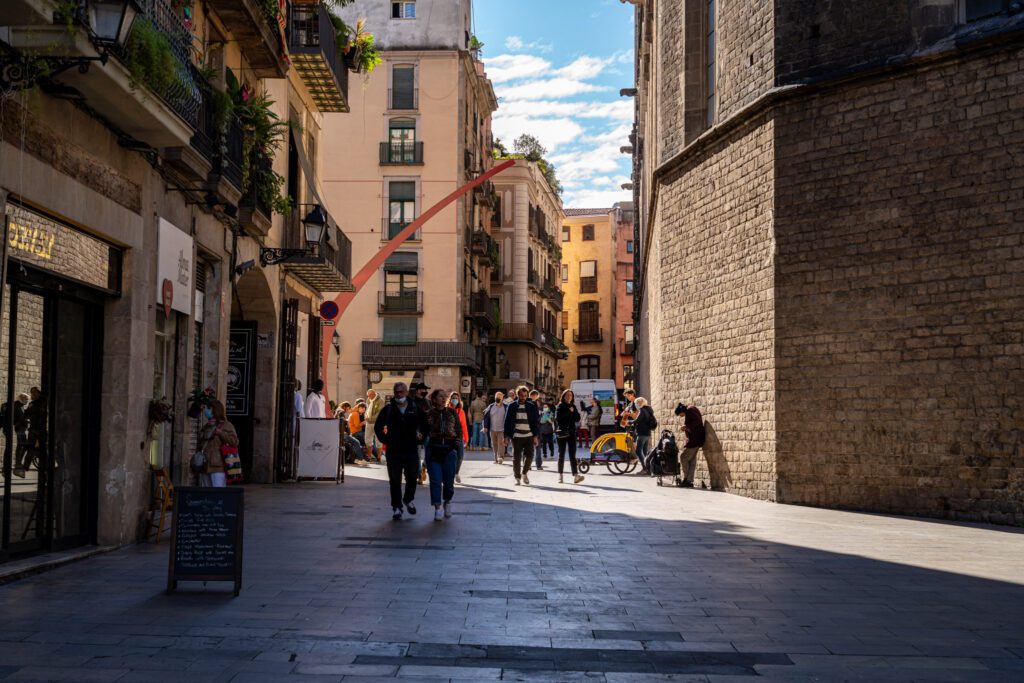
As we mentioned above in the geography section, the main part of the Ciutat Vella is made up of three distinct areas (plus Barceloneta, which looks and feels very different).
El Born is the easternmost section, and is a little corner of the old city tucked alongside Parc de la Ciutadella that is actually made up of three different sub-neighborhoods (La Ribera, Sant Pere, and Santa Caterina – otherwise known as Sant Pere, Santa Caterina i la Ribera).
But everybody calls in El Born, so that’s what we’re going to go with too.
El Born is an interesting combination.
On one hand, it feels pretty similar to the Gothic Quarter in terms of the narrow streets and alleys (with surprise churches!).
But for whatever reason, it has suffered less from the overtourism that plagues the Gothic Quarter, and there are still local businesses that occupy El Born.
That’s not to say there aren’t tourists in El Born – there very much are – but the lack of local businesses in the Gothic Quarter is really what makes it feel a little hollowed out (at least to us), and El Born has plenty of those.
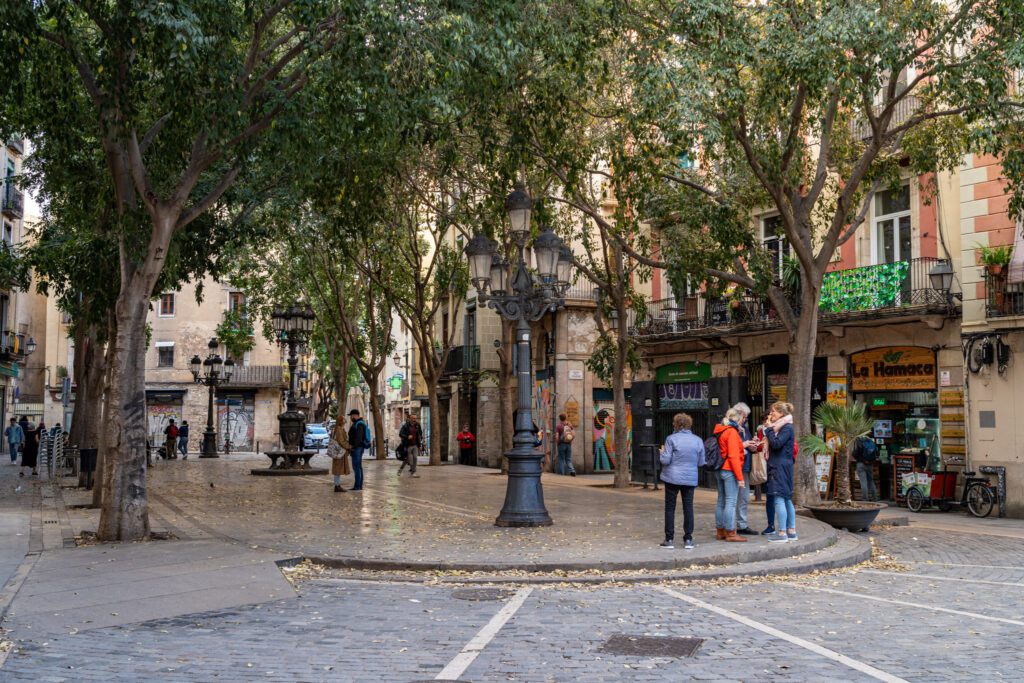
At the center of the neighborhood, you’ll find the Basilica of Santa Maria del Mar, which comes out of nowhere as you emerge from the narrow streets at its base.
It’s about as central as it gets without staying on La Rambla itself. To the east, you have Parc Ciutadella. To the west is the Gothic Quarter, the historic center of Barcelona.
South is Barceloneta, and if you head north you’ll run into Gaudi’s masterpiece and one of the most intricate and fascinating religious places in the world – the Sagrada Familia.
Pros and Cons of Staying in El Born
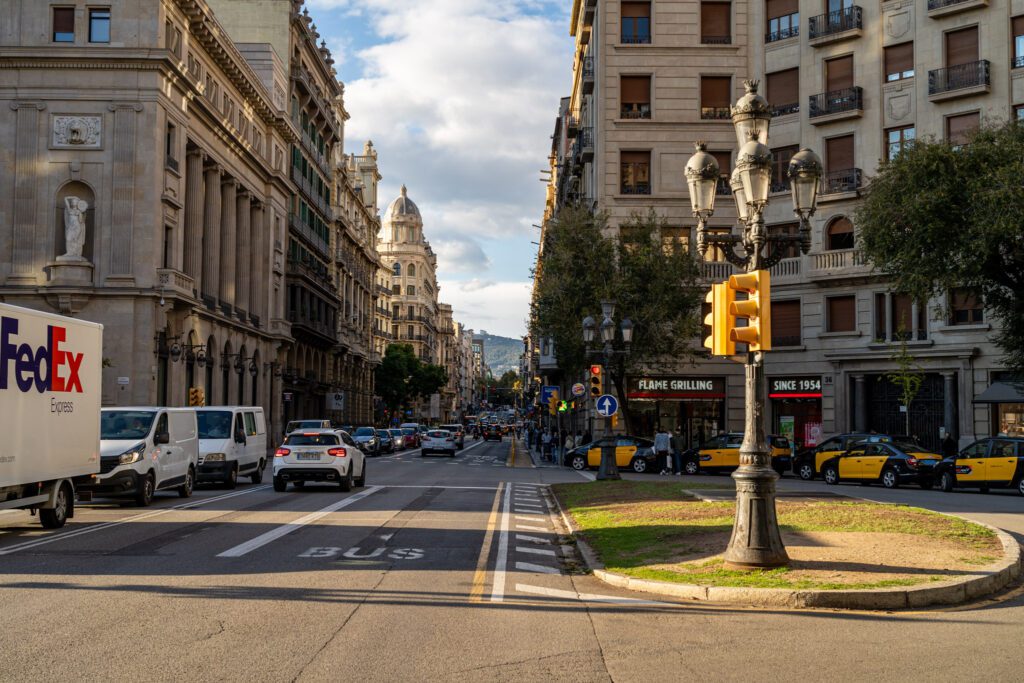
Here are the pros and cons of staying in El Born as we see them.
Pros of Staying in El Born
Great Nightlife. If you’re looking for cozy cocktail bars or places to go dancing until the early hours of the morning, El Born has what you’re looking for. Go after dark to see it at its most energetic.
Super Central. You’ll be within walking distance of just about everywhere in Barcelona, and for the places you can’t walk (Parc Güell, for example) you can hop on the metro, which is an easy walk from most points in El Born.
Romantic and Charming. Narrow streets, bustling plazas, and towering churches. It feels like you’re in a medieval city, mostly because… you sort of are.
Cons of Staying in El Born
It’s Expensive. As you might imagine, staying in a place that’s both central and trendy often comes with a high price tag.
Limited Options in Terms of Places to Stay. Which exacerbates the “expensive” point above. Not that many hotels, and you should stay away from renting an Airbnb in Barcelona.
The Gothic Quarter: Narrow Alleyways and Lots of Tourists
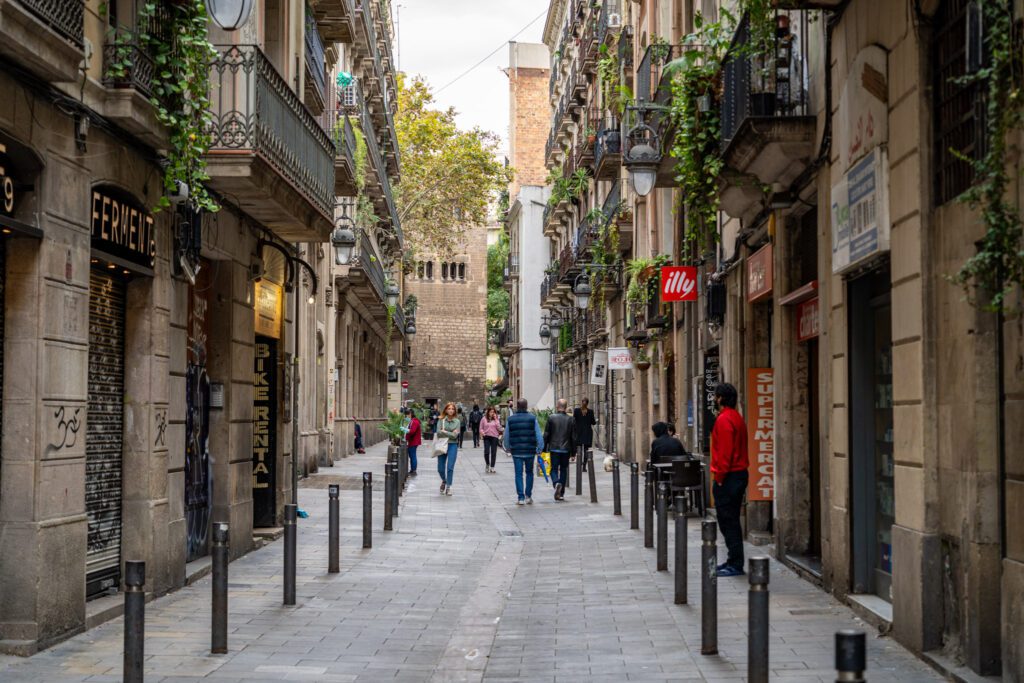
The Gothic Quarter, home to the famous La Rambla, is the most heavily-visited area in the city. Of the words you hear spoken in the Gothic Quarter, the majority are likely to be in a language other than Spanish or Catalan.
Still, despite the fact that this entire area is built specifically to cater to tourists with shops selling knick-knacks and souvenirs that only tourists buy (and only a very specific type of tourists, usually, the ones who come on the giant cruise ships that dock nearby), there’s something very romantic about the narrow alleys and pedestrian-only streets of the Gothic Quarter.
The former Jewish Quarter (“El Call”), in particular, is one of our favorite parts of the city.
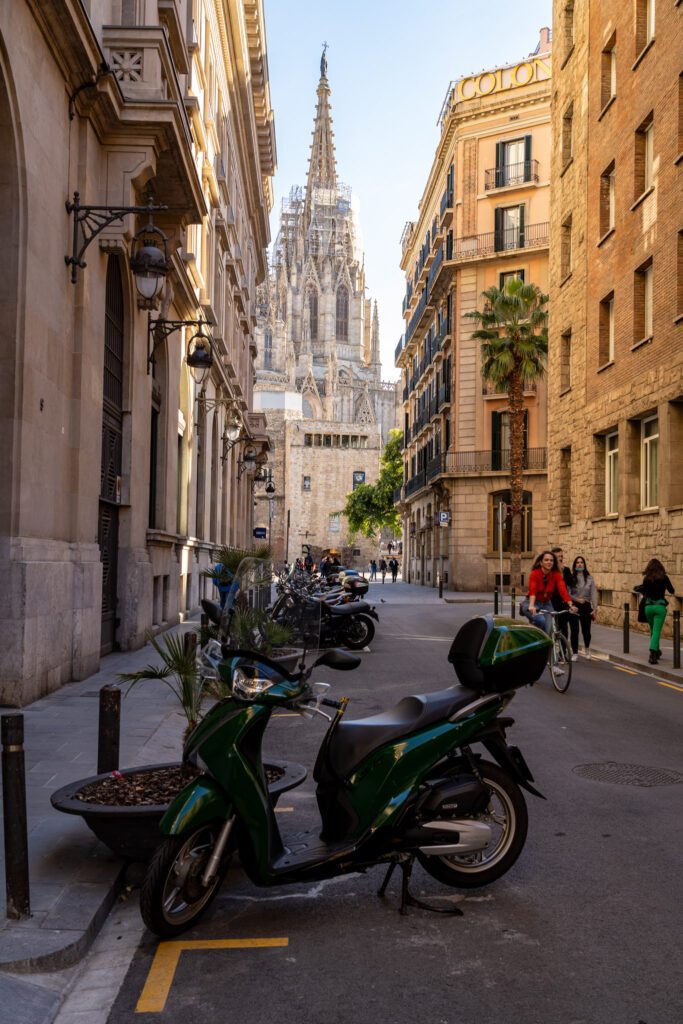
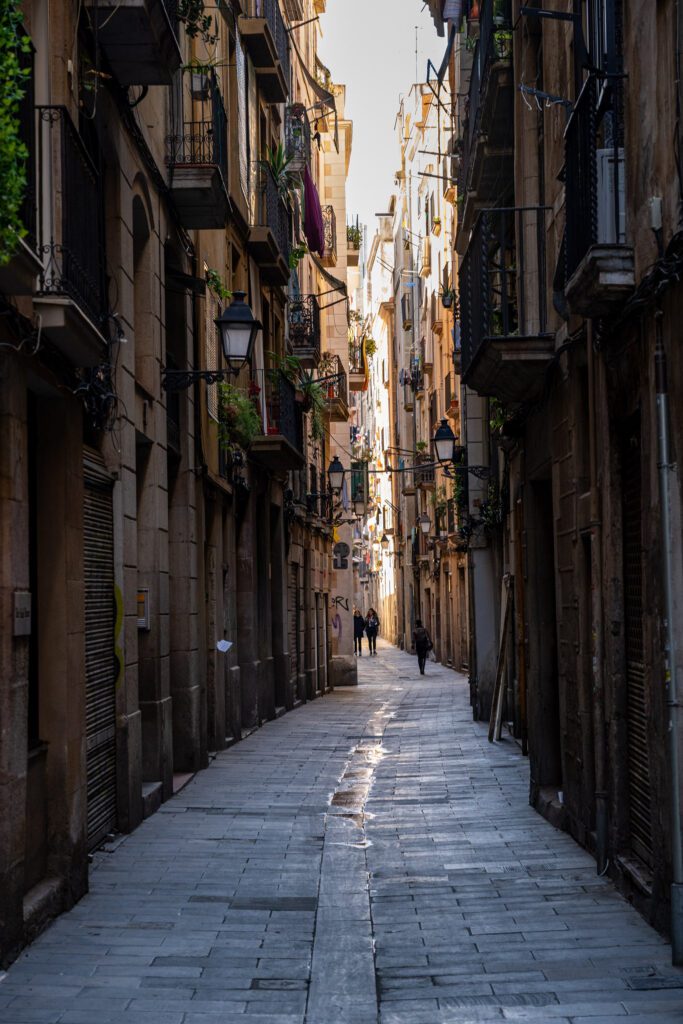
We’d highly recommend staying at least a block or two off of La Rambla if you do choose to stay here.
You’re going to pay a bit more than your room is worth anywhere in this part of the city since it’s so central and charming, but that issue is particularly bad around La Rambla, where hotels (and restaurants, for that matter) don’t even have to try to be good because of the location.
For what it’s worth, we’d much prefer the charm and ambiance of El Born, if you’re set on staying in the old city.
Pros and Cons of Staying in the Gothic Quarter
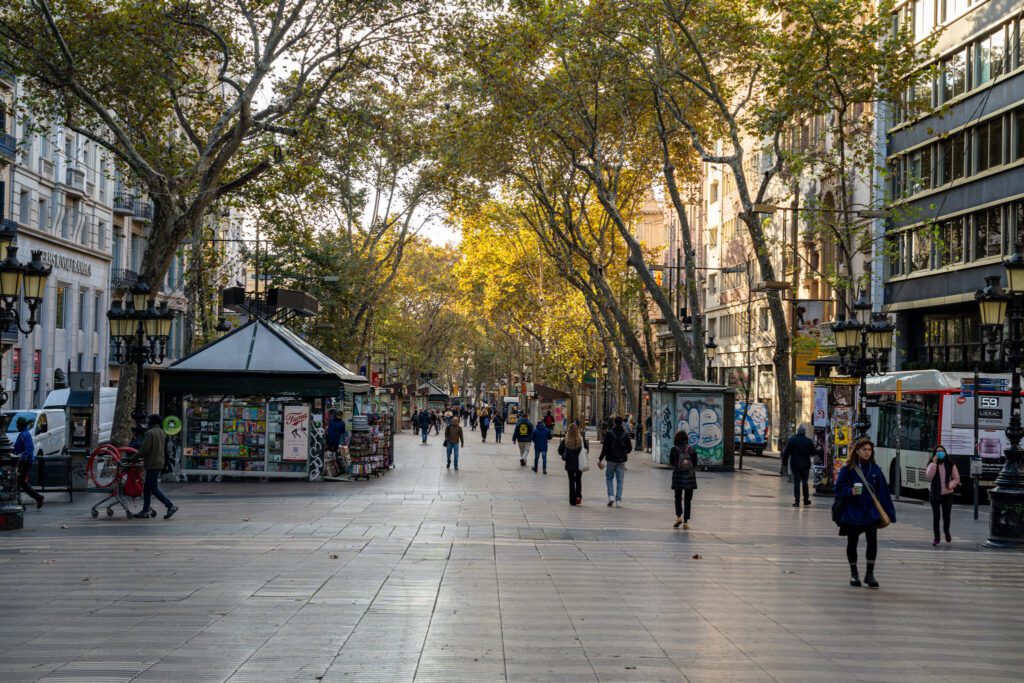
Here are the pros and cons of staying in the Gothic Quarter as we see them.
Pros of Staying in the Gothic Quarter
Romantic and Charming. Narrow alleys. Cobblestone streets. Plazas that emerge from seemingly out of nowhere. Once you leave La Rambla, it feels like you’re in a medieval town.
THE Most Central Neighborhood. As you might imagine, the Gothic Quarter, which is the center of the Old Town, is the most central part of the city. Within about 15 minutes you can walk to El Raval, L’Eixample, and El Born, along with Barceloneta.
Cons of Staying in the Gothic Quarter
It’s Basically Exclusively Tourists. Around every corner, you’ll find a pack of tourists. Sometimes hundreds all shuffling along listening to a guide on a headset, if there’s a cruise ship in town (spoiler: there probably is).
Everything in the Gothic Quarter caters to tourists, though that’s not necessarily a bad thing – it’s just a specific vibe that’s worth knowing ahead of time.
La Rambla. Is this the most famous street in all of Spain? It’s at the top of the list for sure. We also think it’s the worst street in the country.
It’s worth strolling once, from Placa de Catalunya to the Columbus statue with a stop at La Boqueria, but we wouldn’t eat, drink, or spend much time at all within a block or two of this heavily-trafficked, highly overrated boulevard.
Barceloneta: A Vibrant Neighborhood with an Overrated Beach
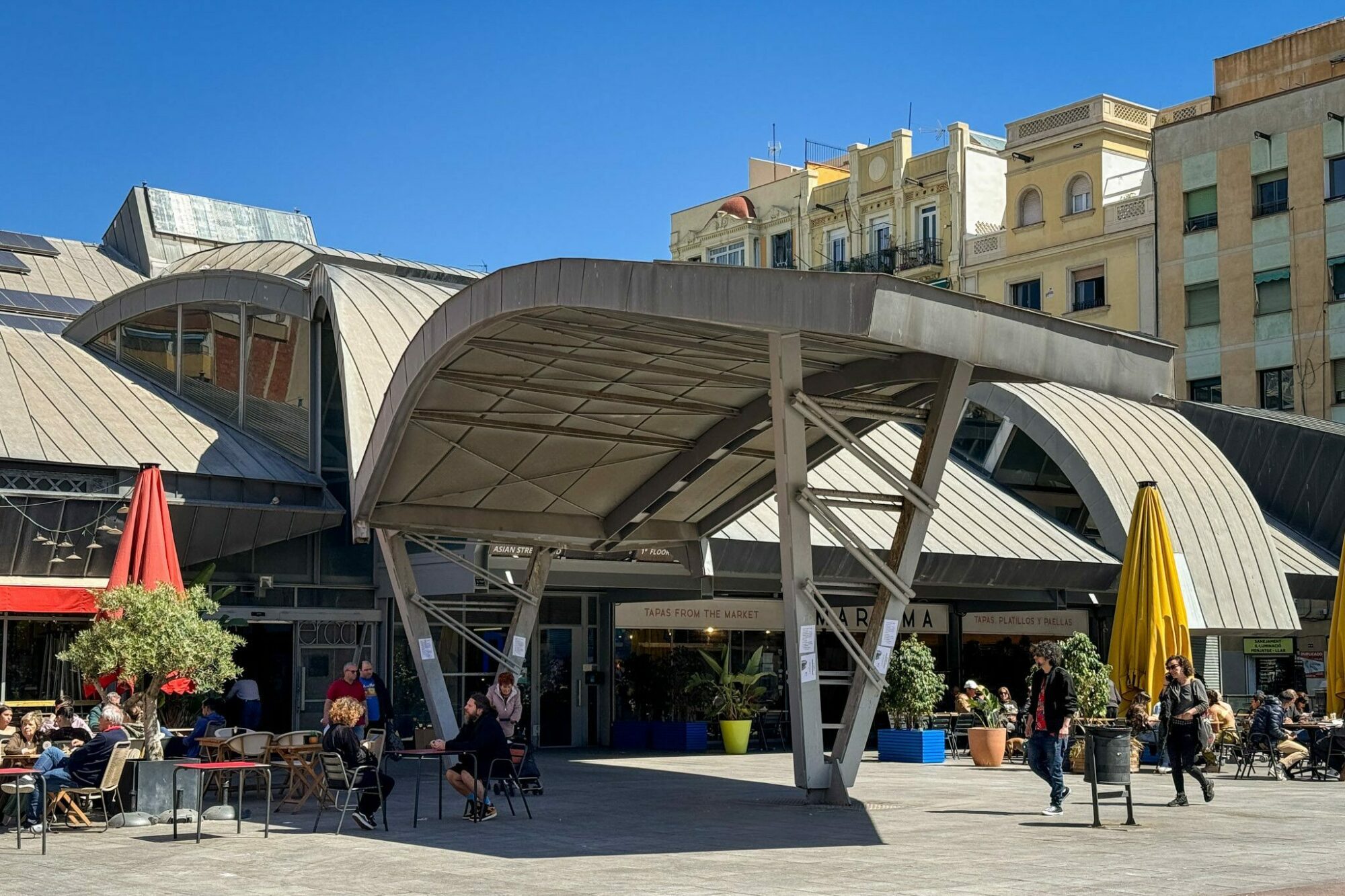
Originally, I thought of Barceloneta as exclusively an area for the beach, which is a wide, sandy affair on the Mediterranean. We’re not huge beach people, so we kind of dismissed it and completely neglected including it in an earlier version of this guide.
However, after connecting with two locals on my latest trip during/after tours, I can firmly say that there’s A LOT more going on in Barceloneta than just the beach (spoiler: it’s mostly great food and drinks).
I actually had the privilege of walking through Barceloneta with Elvira, my guide on my walking tour with With Locals (highly recommend both the tour and Elvira as a guide!), and that’s when it clicked for me that Barceloneta is more than the beach.
We went to Mercat de la Barceloneta, which is a cornucopia of Catalan food (though I have Celiac Disease, which is a lot more complicated).
To get there, we walked through the narrow streets lined by tall apartment buildings adorned with Catalan flags, and I realized that “oh yeah, people live here.”
Barceloneta as a neighborhood is a triangular manmade peninsula that juts out into the Mediterranean, bordered by the sea, El Born, and Poblenou (and Parc de la Ciutadella).
Generally speaking, the closer you get to the beach at the southern tip, the more generic it becomes.
This part of the city has a high concentration of vacation rental listings, and their presence is hollowing out the neighborhood, forcing locals out as landlords chase the tourist money.
Like we’ve said before in this guide, we firmly believe that we as travelers should stay in hotels (or aparthotels), rather than individual vacation rentals, which hurt local communities by increasing housing prices and destroying the sense of community in the area with a revolving door of one to two day residents.
Which brings us to the biggest issue with Barceloneta: there’s really only one or two places to stay. Which is fine, that means it’s probably worth visiting during your trip, but staying elsewhere.
Pros and Cons of Staying in Barceloneta
Here are the pros and cons of staying in Barceloneta as we see them.
Pros of Staying in Barceloneta
The Beach. The main reason to stay here is probably the beach, though it’s not the best beach in the city, we’d say.
If you want to soak up the beach vibes while still being within walking distance of a bunch of great places to eat and drink (and an easy ride to other parts of the city), Barceloneta is a good option.
Good Food and Drinks. As we’ll cover in a second, this part of the city has retained some of the local residents and businesses that give it its character, and as a result there are some pretty good places to eat and drink here (more specifics in a second).
Cons of Staying in Barceloneta
It’s Not Particularly Well Connected. There’s a metro stop on the border with El Born (called Barceloneta), but as you get deeper into the peninsula, the connections become a little more tenuous, and you’re going to have a short walk to access the metro and buses.
The Beach is Madness in the Summer. It’s the busiest part of Barcelona come July and August, and we’d actually just completely avoid it during that period. Head out to Poblenou a little further up the coast for better beaches that are more relaxed.
There Aren’t Many Places to Stay. While there are a bunch of short term vacation rentals here (but we’ve covered that you should avoid these in Barcelona), there are only a couple of hotels in Barceloneta, which means your choices are few and far between. The main hotel – the beautiful W Hotel at the tip of the peninsula – is also pretty far from the metro.
Planning a trip to Spain? We’d love to help!
Here are our other Spain travel guides to help you plan an incredible trip (even if you have to eat gluten free!).
If there’s no link below, it means we’re still working on it – long, in-depth guides take time! We’re working on it, though, we promise.
The first place to start, if you haven’t already found them, is with our detailed itineraries. We have one shorter version for 7 days in Spain, one version that covers 10 days in Spain (a good middle ground, we think), and one longer version for two weeks in Spain (with ideas for more and less time in both guides).
Our Barcelona Guides
- What to do in Barcelona (as a First Timer)
- How to Plan an Amazing 4 Day Barcelona Itinerary
- Where to Stay in Barcelona: A Complete Guide for First Timers
- 12 Things to Know Before You Visit Barcelona
- Gluten Free Barcelona: A Complete Guide to GF Restaurants + Bakeries
- Where to Find the Best Specialty Coffee in Barcelona
- How to Plan an Incredible Day Trip to Montserrat (from Barcelona)
Our Madrid Guides
- What to do in Madrid (as a First Timer)
- How to Plan an Amazing Madrid Itinerary (2 Days)
- Where to Stay in Madrid: A Complete Guide for First Timers
- 12 Things to Know Before You Visit Madrid
- Gluten Free Madrid: A Complete Guide to GF Restaurants + Bakeries
- Where to Find the Best Specialty Coffee in Madrid (for Coffee Nerds)
- How to Plan an Amazing Day Trip to Toledo (from Madrid)
The Rest of Spain

Me, my husband and sister in law are planning a trip to Spain in May. I just want to comment that your travel blog is wonderful. I have read “14 days in Spain” and plan to follow your recommended itinerary. My sister in law also has celiac disease so it seems like it was meant to be that I found it! Plus I live in Portland! One question I have is : can I print out the info? I hope so!
Thanks, Jill
Hey Jill! You hit the trifecta – Portland, Celiac, and planning a trip to Spain. Cheers to that!
Unfortunately, we don’t have a great way to print out the info, but you can hit “print” and save as a PDF (the only problem is that our guides are really long and have ads, which you can’t really remove using that technique.